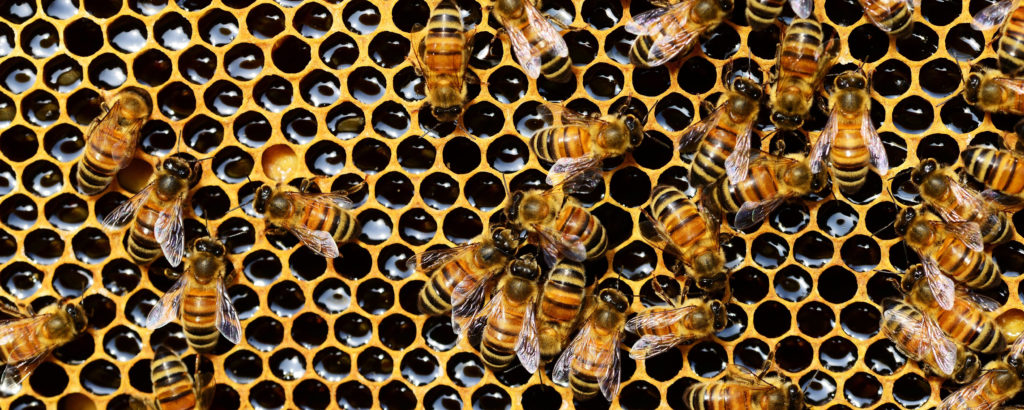Press Release
Feb 28, 2020
Study finds rise in allergy to natural skincare ingredient

Skin allergy to an ingredient found in many natural skin products has more than doubled since 2007, according to a study in the British Journal of Dermatology.
The analysis of 125,436 people tested for skin allergy between 2007 and 2018 across Germany, Austria and Switzerland, found a significant rise in allergy to propolis, also known as ‘bee glue’.
Propolis is created and used by bees to help construct their nests. It consists of materials from living plants mixed with an enzyme present in the bees’ saliva, partially digested and added to beeswax to form raw propolis. It has antibacterial, antifungal, and antiviral properties and is available as a dietary supplement, in health products, and as a constituent of many ‘natural’ cosmetics and skincare products.
Contact allergy occurs when the skin comes into contact with allergens, causing sensitisation. This means that if the skin is exposed to the same allergen again, it can develop an eczematous reaction known as allergic contact dermatitis. Symptoms of contact allergy include redness and swelling of the skin, blisters, pimples and itching.
Patch testing is used by dermatologists to determine which substance is causing the reaction, by applying a range of known allergens, called the baseline series, to small areas of skin to see which trigger a reaction.
This latest study uses data gathered from people undergoing patch tests across 56 centres forming The Information Network of Departments of Dermatology.
It found that in the period of 2007 to 2010, 2.35% of patch tested people were found to be allergic to propolis, compared to 3.94% in 2015 to 2018, an increase of 68%.
Nina Goad of the British Association of Dermatologists said: “Currently, propolis is not routinely included in patch testing in the UK, so the level of allergies here cannot be fully established. However, if trends in its use in the UK show an increase, a similar situation would be expected in our allergy clinics.
“While there may be benefits to natural skincare products, it shouldn’t be assumed that they are safer for the skin than their non-natural counterparts. If you experience a skin reaction, don’t rule out a natural skin product as the culprit, and let your doctor know about anything that your skin has been in contact with.”
Professor Wolfgang Uter, lead author of the study, said: “The increase in allergy to propolis that we have observed certainly warrants targeted investigation of what is driving sensitisation. At present, we do not know the full extent of its availability and how widely it is used. If the allergy trend continues, we will need to consider a reassessment of risk, and probably risk management such as a limit on the concentration of propolis allowed in products that are left on the skin.”
Propolis can be found in a range of cosmetics including shampoos, conditioners, ointments, lotions, lipsticks and lip balms, and toothpastes.
It has been used by humans for thousands of years. In ancient Egypt, it was used for embalming the dead. Aristotle, in around 330 BC, reported the first use in medicine, and records from the 12th century describe medicinal preparations with propolis. Later, it was often used to treat skin wounds and to protect raw skin before bandages were available. Nowadays, it is used across a wide spectrum of healthcare and cosmetic products.
-Ends-
Peer Reviewed | Observational study | People
Study details:
British Journal of Dermatology: Trends and current spectrum of contact allergy in Central Europe: Results of the Information Network of Departments of Dermatology (IVDK), 2007 — 2018
W. Uter,1 O. Gefeller,1 V. Mahler2 and J. Geier3.
1Department of Medical Informatics, Biometry and Epidemiology, University of Erlangen/Nürnberg, Erlangen, Germany.
2Paul Ehrlich Institut, Langen, Germany.
3Information Network of Departments of Dermatology, University Medical Center, Göttingen, Germany
Link to full study: https://doi.org/10.1111/bjd.18946
For more information please contact the media team: comms@bad.org.uk, 0207 391 6084. Website: www.bad.org.uk/public
About us:
The British Association of Dermatologists is the central association of practising UK dermatologists. Our aim is to continually improve the treatment and understanding of skin disease. For further information about the charity, visit www.bad.org.uk/public
The British Association of Dermatologists publishes two world-renowned dermatology journals, both published by Wiley-Blackwell. The British Journal of Dermatology is one of the top dermatology journals in the world and publishes papers on all aspects of the biology and pathology of the skin. http://onlinelibrary.wiley.com/journal/10.1111/(ISSN)1365-2133